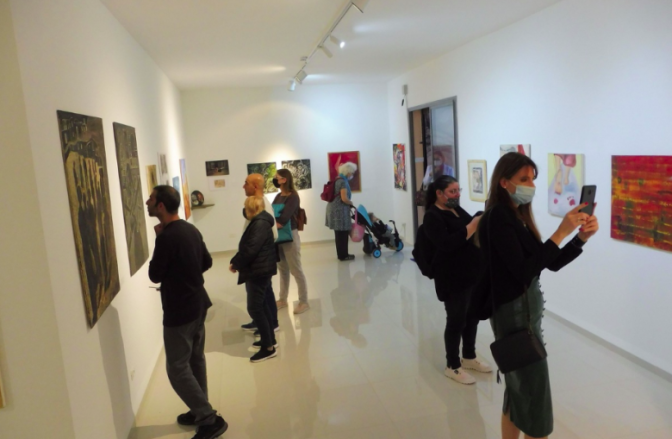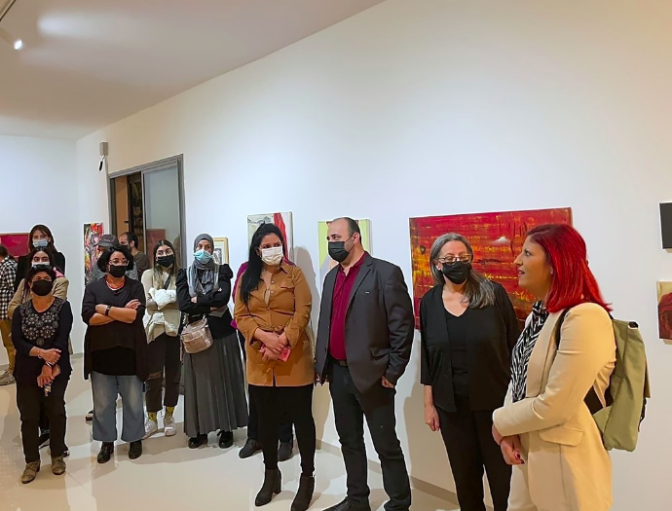Home > Oasis of Peace > Projects & Outreach > Art Gallery > "Me is WE, I am SHE" opens at the Oasis Art Gallery
"Me is WE, I am SHE" opens at the Oasis Art Gallery
Thursday 2 December 2021

On Sunday, November 28, the Oasis Art Gallery opened a new exhibition titled “Me is We, I am She”, which focused on the subject of violence against women in particular and human rights in general.
The exhibition is our local contribution to the Global 16 Days Campaign, which runs between two dates in the UN calendar: The International Day for the Elimination of Violence Against Women and International Human Rights Day.

Four artists were represented at the exhibition: Taghreed Habeb, Assaf Rahat, Elias Akleh and Lital Sharoni. Each of them contributed works they felt best matched the themes. Many of their paintings were made as a form of protest. They took the audience out of their comfort zone and forced them to confront the reality of violence against women and the fear and vulnerability felt by women in our society. The images presented by Lital Sharoni showed this most graphically. Others expressed broader human rights themes, such as a series of sketches of homeless people and a painting of a refugee boat called “The Ghosts,” by Assaf Rahat. The subject of Palestinian refugees was also not forgotten, such as in the painting “The Paper Left Behind” by Taghreed Habeb. Elias Akleh, in his own impressionist works such as “Conquest of Paradise”, presents our struggle to reach for a higher meaning and purpose despite the suffering we experience.
The evening ran from 16:00 to around 18:00 and was attended by members of the community, people from the surrounding area, friends of the Gallery, three of the four artists, and some of their family members. Dyana Shalufi Rizek, the gallery curator, introduced the artists and gave them the opportunity to say some words about their creations. The artist Assaf Rahat sent apologies that he was unable to attend, so Dyana introduced his artworks in his stead.
The artists were visibly moved by the opportunity to speak about their art works. Due to the difficult nature of the themes, and the provocative style of some of the works, this was in some cases not so easy for them. “After all,” as Lital Sharoni noted afterwards, “My way of expressing myself best is through my art. There, I can say with complete confidence what it is hard for me to put into words…” But Dyana and the audience inspired the artists to speak out anyway.

After viewing the exhibition we gathered in the gallery courtyard for a discussion led by WASNS development director and activist Samah Salaime and WASNS member and political educator Michal Zak. Samah spoke generally on the theme of the struggle for elimination of violence against women in Arab and Jewish society, brought hard statistical evidence from the reality on the ground. Michal said that among the dilemmas that we have faced as a community has been whether to focus entirely on the issue of the Palestinian – Jewish Israeli conflict and shared society, or whether to open up and confront other crucial struggles (such as gender inequality). She said that after the initial years of the community, we began to understand that it is impossible to separate between the many issues that need to be confronted, and that, like activists everywhere, we saw the necessity to unify between struggles.
After having their emotions joggled by the exhibition itself, the participants did not find it difficult to speak about what they had experienced and to bring to the circle a variety of different viewpoints.
Each of the artists later wrote about their impressions from the evening. Taghreed Habeb: “The topic was human rights in particular and the fight against violence and against killing women. It ended with a sophisticated dialogue and the hearing of many opinions aimed at reforming our society. Many thanks to the artist Dyana Shaloufi Rizek, who organized the exhibition in a wonderful and extraordinary way for an audience of intelligent people from WASNS and the surrounding area.”
Elias Akleh: “How brilliant that all works are distinctive and interconnected with the topic. The place, gallery and village are great and you are an extraordinary person… I was very happy to be with you all and to get to know you.”
Lital Sharoni wrote at length. Among her words: “I met some amazing women… Dyana, especially was wonderful – her words expressed her appreciation for me and, more importantly, gave me a sense of security. There was a cycle of dialogue that raised many questions in a discourse moderated by two inspiring activists! They filled me with a hope that I have been missing lately. I was privileged to receive compliments and love that I did not expect and did not know how to contain them all. You moved me so much! I fulfilled a dream! I dreamed that my works would provoke a dialogue and raise substantive questions. I was asked questions that helped me describe things I had never said out loud. I felt this was important despite the anxiety it aroused in me.” She mentions also that when she had attempted to post a photo of her works at the exhibition on Facebook, these were removed and she was threatened with being banned from the network.
Dyana says, “I believe that the themes of our exhibitions are all interconnected: whether we take up the issue of violence against women or deal with injustice shown towards citizens; whether the subject is ending the occupation or protecting the environment, our objective is essentially the same. The gallery gives us an important tool to raise awareness. It provides inspiration, and urges us to take responsibility for our world.”
The exhibition will remain in place for the coming months. According to the artists, and the impressions from the audience, it has already contributed to the crucial discourse on the theme of eliminating violence towards women and the protection of our human rights.
See photo gallery


